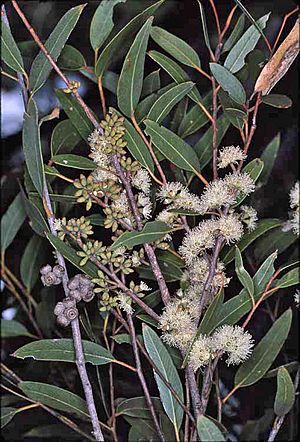White stringybark facts for kids
Quick facts for kids White stringybark |
|
|---|---|
 |
|
| Leaves, flowers, and fruits of Eucalyptus globoidea at the ANBG | |
| Scientific classification | |
| Genus: |
Eucalyptus
|
| Species: |
globoidea
|
| Synonyms | |
|
|
The Eucalyptus globoidea, also known as the white stringybark, is a type of tree. It grows only in certain areas, mainly near the coast in south-eastern Australia. This tree has rough bark that looks like strings. Its leaves are shiny and shaped like spears or eggs. It produces small, round fruits and white flowers.
Contents
About the White Stringybark Tree
The white stringybark tree can grow very tall, reaching up to 30–40 metres (98–131 ft) high. Its bark is rough and stringy, covering the trunk and even the thinner branches. The bark is usually grey to reddish-brown and often has deep grooves on the main trunk.
Young trees have shiny green leaves that are lighter underneath. These leaves are shaped like eggs or wide spears, measuring about 40–100 mm (2–4 in) long and 20–45 mm (0.8–2 in) wide. They often have a wavy edge.
As the tree gets older, its leaves change. Adult leaves are shaped like eggs or spears, often a bit curved. They are shiny green on both sides, about 70–135 mm (3–5 in) long and 12–40 mm (0.5–2 in) wide.
Flowers and Fruit
The white stringybark's flowers grow in groups, usually with eleven to fifteen flowers in each cluster. These clusters are found on a flat stem called a peduncle, which is about 4–10 mm (0.2–0.4 in) long. Each individual flower sits on a tiny stem called a pedicel, up to 2 mm (0.08 in) long.
Before they open, the flower buds are green to yellowish and shaped like ovals or spindles. They are about 5–7 mm (0.2–0.3 in) long and 3–4 mm (0.1–0.2 in) wide. The top part of the bud, called the operculum, is cone-shaped. The flowers have white stamens, which are the parts that produce pollen.
White stringybark trees usually flower from July to February, but most flowers appear between September and January. After flowering, the tree produces small, round or half-round fruits. These fruits are called capsules and are about 4–7 mm (0.2–0.3 in) long and 6–9 mm (0.2–0.4 in) wide.
How it Got its Name
The Eucalyptus globoidea was first officially described in 1927. This was done by a person named William Blakely. He wrote about it in a scientific journal called Journal and Proceedings of the Royal Society of New South Wales.
The second part of its scientific name, globoidea, comes from a Latin word, globoideus. This word means "globoid" or "sphere-like". It was chosen because the fruit of this tree is shaped like a small globe or sphere.
Where White Stringybark Grows
The white stringybark tree grows in forests and woodlands. You can find it on hills and slopes along the coast and nearby tablelands. Its range stretches from Woolgoolga in New South Wales down to areas near Melbourne in Victoria.
-
A white stringybark tree near Bermagui
-
Close-up of the bark on a white stringybark tree near Eden
-
New leaves growing after a fire in Ku-ring-gai Chase National Park
-
Fruits of Eucalyptus globoidea at Ku-ring-gai Chase National Park
See also
 In Spanish: Corteza fibrosa blanca para niños
In Spanish: Corteza fibrosa blanca para niños





